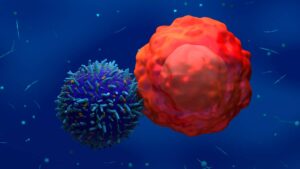Dr Boreham’s Crucible: Will there be a sting in the Chimeric Therapeutics tale?

Pic: Luis Alvarez / DigitalVision via Getty Images
‘Deathstalker Scorpion’ sounds like a title for a boy’s own war movie adapted from an Alistair Maclean novel, rather than a potential immune therapy-based cancer treatment.
We’re talking about a real arachnid, Leiurus quinqestriatus, which secretes chlorotoxins that bind to unique targets in the body.
The recently listed Chimeric (ASX:CHM) is right onto the therapeutic potential, having launched a clinical program to treat glioblastoma (brain cancer) with a peptide derived from the venom.
As they say in the Special Air Services: who dares wins … and what doesn’t kill you makes you stronger.
At around $9,000 per gram, this toxin is one of the most expensive substances on the planet. But for Chimeric’s purposes, the toxin – which has been used for years as an imaging agent – is synthesized.
“A poor sod doesn’t have to go out to the desert and milk scorpions,” says Chimeric’s executive chair Paul Hopper.
About Chimeric
Pronounced ‘ky-meric’, Chimeric is an exponent of emerging CAR-T therapies, which involve jiggling about with the body’s T-cells to whomp tumours.
Chimeric shares soared on their January 18 ASX debut, which partly reflects the popularity of this emerging field.
The other reason is the Hopper Factor. One of Aussie biotech’s foremost entrepreneurs, Hopper has founded – or been involved in – no fewer than 14 drug companies, mainly in oncology (see below).
Chimeric is based on its CLTX CAR-T technology, acquired from the City of Hope Hospital in Los Angeles.
CLTX refers to chlorotoxin, while CAR-T is short for chimeric antigen receptor T-Cell (and not a T-model Ford).
Hopper says he tried to winkle the technology from City of Hope six years ago, but was outbid by another pesky company.
In the end, his close links with the institution’s research scientists paid off and its technology transfer office agreed to hive off the assets.
So far, the US Food and Drug Administration has approved three CAR-T drugs for blood cancers (leukaemia and lymphoma): Kymriah, Tecartus and Yescarta.
So far, there’s nothing for solid cancers, but with no fewer than 50 glioblastoma or glioma trials underway, Chimeric claims to be the only exponent incorporating a peptide toxin into a CAR-T cell therapy and entering human clinical trials.
The CLTX peptide also shows promise as a radiotherapy delivery conjugate and imaging agent in fluorescent-guided surgery.
Wheels within wheels
Chimeric’s underlying intellectual property was devised by City of Hope researchers Prof Christine Brown and Dr Michael Barish.
The former chairs Chimeric’s scientific advisory board.
There’s an interesting nexus with fellow ASX-listed immuno-oncology play Imugene which Mr Hopper founded: Imugene chief Leslie Chong is one of Chimeric’s three directors.
Chimeric’s talent pool is rounded out by chief operating officer Jennifer Chow, who held senior marketing and commercial roles at US CAR-T specialist Kite Pharmaceuticals.
Chief medical officer Dr Syed Rizvi was an executive at the Nasdaq-listed Legend Biotech.
Hopper said it was “extraordinarily lucky” that this talent was available.
“They are the crème de la crème of the CAR-T space. It’s a high-powered team for a little Aussie biotech.”
In early February the company then announced that a former Juno Pharmaceuticals heavyweight, Cindy Elkins, would join the board.
A cancer treatment with bite
CAR-T treatments involve taking T-cells from a patient and ‘reprogramming’ them.
“T-cells are one of the main soldiers of the immune system,” Hopper says. “If they see anything nasty, they clean it up and get rid of it.
“Unfortunately, they don’t always work when they see cancer.”
Formally known as a 36 amino acid peptide, the scorpion toxin recognises a cancer marker called membrane-bound matrix metalloprotease-2 (MMP2).
Like a guided missile, the payload seeks the MMP2 target as the ‘bull’s eye’ and targets it on a search-and-destroy mission.
The ‘civilians’ – the healthy cells – are unharmed.
(City of) Hope for successful trial
Aside from the unmet medical need, Hopper says Chimeric chose glioblastoma because of “pretty stunning” pre-clinical in-vitro and in-vivo data.
A phase I trial is unfolding at the City of Hope.
The trial guardians have started recruiting the first of 18 patients in the open-label, dose-escalation trial, which is expected to go for 18 to 24 months.
First data is expected by December this year.
Strictly speaking, it’s just a safety trial but as Hopper notes: “Anyone who runs a phase I study has a look to see if the drug is sending a signal.”
Should the trial be deemed a success, the company will move to a 50 to 75 patient trial, which could be pivotal for the drug and the company.
Hopper to it
The Chimeric play is consistent with Hopper’s modus operandi of gathering backers to obtain intellectual property through tight networks, then hiving off the entity he holds to an already listed or newly-listed company for a tidy sum.
“I have never had a lot of trouble raising money,” he says.
While he’s the maestro of conjuring-up the cash, Hopper is also hands-on, generally staying on as a director and sometimes as CEO or executive chair.
The endgame is to sell the assets well before a drug is approved (or not, as may well be the case).
Hopper has founded – or seeded the technology into – ASX-listed biotechs including Patrys, Kazia (formerly Novogen) and Prescient Therapeutics.
He kicked-off melanoma outfit Polynoma LLC, acquired by the Hong Kong based CK Life Sciences, as well as Glioblast (acquired by Novogen).
He founded Bioscience Oncology, which was based on tech from the City of Hope. Scopus Biopharma bought the company in June last year and listed on the Nasdaq in December.
Hopper is executive chair of Imugene, having vended in a mob called Vaxinia which acquired a chimeric pox virus patent from … drum roll … the City of Hope.
And do we need to mention that he chaired immuno-oncology play Viralytics, famously sold to Merck for $504 million in 2017?
While Hopper delves mainly into cancer therapeutics, he is also chair of Suda Pharmaceuticals, which is reformulating drugs into oral sprays, but last year failed to back-door a cancer technology into the company.
Is that enough?
No, actually: he is executive chair of the US private company C19 Therapeutics – as in Covid-19 – a non-vaccine play based on tech from the Virginia Commonwealth University.
The scary thing is this list of Hopper’s past and present interests is not exhaustive.
Finances and performance
Chimeric sought – and banked – $35 million in its initial public offer, but returned the cheques to investors, who are further seeking another $60 million.
Given the unrequited demand, we shouldn’t be surprised the 20 cents shares spurted as high as 41 cents. With the usual stags taking first-day profits, the stock has retreated, but there’s still a 50 per cent gain on the table.
With a 25 per cent stake worth $25 million, Hopper is by far the biggest shareholder and has this one tied up like pussy’s bow.
But looking over his shoulder are heavyweight shareholders including IFM Investors, Thorney Investments, Regal Funds Management and Andrew Banks (co-founder of recruiter Morgan & Banks but better known as an investor on the Shark Tank reality TV show).
Chimeric share price today:
Dr Boreham’s diagnosis:
Chimeric is girded by the reality that fewer than five per cent of glioblastoma patients survive for more than five years.
(US political wonks will know that the condition killed Joe Biden’s son Beau, one-time Republican candidate John McCain and McCain’s old adversary Edward Kennedy).
Hopper says the company will know pretty quickly whether the drug works, because it is going into glioblastoma patients who have already had cancers cut out (only for them to recur).
“They are not in great shape and when they recur, glioblastoma is pretty aggressive,” he says. “We have a lot of [development] options because there’s not a lot out there.”
Hopper says Chimeric has “all sorts of ideas” about wider clinical trials to show the milk of the scorpion’s wider applications.
“We will do studies with other cancers,” he says. “We haven’t determined the indications but they may be melanoma or lung.”
If the Hopper Playbook is dutifully adhered to, expect the company (or the technology) to be sold well before it needs to stump up big dollars for phase III trials.
Chimeric’s prospectus includes a report from Acuity Technology Management, which opines a CAR-T developer at Chimeric’s stage of progress should be worth $US80 million ($130 million) to “well in excess of $US1 billion”.
CAR-T related mega-deals include the aforementioned Kite being acquired by Gilead for $US11 billion and Legend’s mid-2020 Nasdaq-listing following a $US450 million raising that could have easily garnered $US1 billion.
Meanwhile Hopper keeps on top of his capacious portfolio by working 12 hours days and half the weekend, usually from his regional New South Wales property.
But it’s not all about dollars and the next deal.
“I don’t really see it as work,” he says.
“I work with some of the most brilliant people on earth, it’s inspirational. They are looking into the origins of life and curing cancer.”
Disclosure: Dr Boreham is not a qualified medical practitioner and does not possess a doctorate of any sort. He always thought the most expensive substance on the planet was contained in inkjet printer cartridges.
This column first appeared in Biotech Daily.
UNLOCK INSIGHTS
Discover the untold stories of emerging ASX stocks.
Daily news and expert analysis, it's free to subscribe.
By proceeding, you confirm you understand that we handle personal information in accordance with our Privacy Policy.








